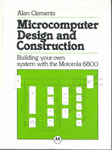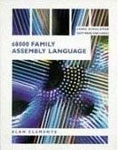| Mark-8 Design | Microcomputer According to Titus | Microcontroller Project | Postscriptum | Lessons Home |
|
This link is a tease aimed at the Competition Director, Professor Clements, since
while working on the project we discovered that he was also one of the early
microcomputer designers, as he states in his article on "Brief History of Microprocessors":
"I built my own microcomputer in 1976 using Motorola's 6800." Consequently,
we dug out his textbook on microcomputer design, published by Prentice Hall,
in 1982, and hacked (not really, just browsed) into his website to learn about his new book, and as a result
produced this page to prove that our concept of educating the general population on
designing microcomputers is viable and the website easily extendable in a format
we are suggesting.
1.Introduction  From Microcomputer Design and Construction
From Microcomputer Design and Constructionby Alan Clements In this chapter four aspects of the TS1 microprocessor system are dealt with. As the nature of a microprocessor system is so heavily affected by the particular microprocessor at its heart, we begin with a description of the actual microprocessor chosen for the TS1. Read More:  Clements Intro 01.pdf [214 KB] Clements Intro 01.pdf [214 KB]2.Binary Number System & 3.Boolean Logic  Professor Clements writes on these topics in his other book:
68000 Family Assembly Language Programming, Thomson
Engineering, 1994
Professor Clements writes on these topics in his other book:
68000 Family Assembly Language Programming, Thomson
Engineering, 1994
4.Digital Circuits  From Microcomputer Design and Construction
From Microcomputer Design and Constructionby Alan Clements These three devices have been included as an appendex because of their great importance in the design of interface circuits and becuase even though many other works... Read More:  Clements Circuits 04.pdf [85 KB] Clements Circuits 04.pdf [85 KB]5.CPU and Memory From Structure of the CPU by Alan Clements We begin by describing the structure of a simple generic CPU. Once we see how a computer operates in principle, we can look at how it may be implemented.We describe the operation of a very simple one-and-a-half address machine whose instructions have two operands; one in memory and one a register. Instructions are written in the form ADD A,B that adds A to B and puts the result in B. Either A or B must be a register. Read More: (File temporarily down)  From Microcomputer Design and Construction
From Microcomputer Design and Constructionby Alan Clements The performance of a microprocessor system may be thought of as being influenced by four factors: the instruction set of the microprocessor, the seepd of the mircoprocessor, the addressing techniques employed by the microprocessor, and the memory. Read More:  Clements Memory 05b.pdf [438 KB] Clements Memory 05b.pdf [438 KB]6.Instruction Set From The Instruction Set Architecture by Alan Clements There are two ways of introducing the processor. One is to explain how a computer works at the level of its internal information flow by describing the way in which information is transmitted between registers and internal units and showing how an instruction is decoded and interpreted (i.e. executed).The other approach is to introduce the native language, or machine code, of a computer and show what computer instructions can do. In practice no-one writes programs in machine code; instead they use assembly language which is a human-readable representation of machine code (see the box 'The assembler'). Read More: (File temporarily down) 7.Addressing Modes  From Microcomputer Design and Construction
From Microcomputer Design and Constructionby Alan Clements There are several different ways in which the three address-decoding strategies defined in the last section may be implemented. In general, address-decoding techniques may be divided into four groups: address decoding using random logic, address decoding using m-line to n-line decoders, address decoding using PROMs and address decoding using programmable logic arrays. Read More:  Clements Addressing07.pdf [177 KB] Clements Addressing07.pdf [177 KB]8.Assembly Language  From Microcomputer Design and Construction
From Microcomputer Design and Constructionby Alan Clements All microprocessor systems, without exception, are composed of two fundamental entities-the hardware and the software. The hardware part of a microprocessor system consists of all the physical components which make up the system, while the software is the program residing in the microprocessor's memory. Read More:  Clements Assembly08.pdf [402 KB] Clements Assembly08.pdf [402 KB]9.Bus and Input-Output  From Microcomputer Design and Construction
From Microcomputer Design and Constructionby Alan Clements A bus is a highway composed of one or more paths which transfer information and electrical power between the various components of a digital system. The concept of a common bus, carrying data from one part of a system to another, is so obvious that it is difficult to imagine a complex digital system without one. Read More:  Clements Bus09.pdf [204 KB] Clements Bus09.pdf [204 KB]10.Interfacing and Interrupts  From Microcomputer Design and Construction
From Microcomputer Design and Constructionby Alan Clements In order to free the CPU from the mundane tasks associated with input or output operations, the microprocessor manufacturers have provided the engineer with a broad spectrum of interface devices. These I/O devices often have circuit complexities which rival those of the CPU itself. Read More:  Clements InterfInterrupts10.pdf [392 KB] Clements InterfInterrupts10.pdf [392 KB]11.Advanced Topics  From Microcomputer Design and Construction
From Microcomputer Design and Constructionby Alan Clements The computational power of any given microprocessor is fixed. It is fixed at the time of its conception by the engineers who design the architecture, and by the technology with which the chip is fabricated. Read More:  Clements Advanced11.pdf [448 KB] Clements Advanced11.pdf [448 KB]12.Design Tools  From Microcomputer Design and Construction
From Microcomputer Design and Constructionby Alan Clements Having decided to construct a microprocessor system, there are three practical considerations to be taken into account: the circuit of the system, the physical construction of the circuit, and the housing of the circuit. Read More:  Clements Design12.pdf [392 KB] Clements Design12.pdf [392 KB] |